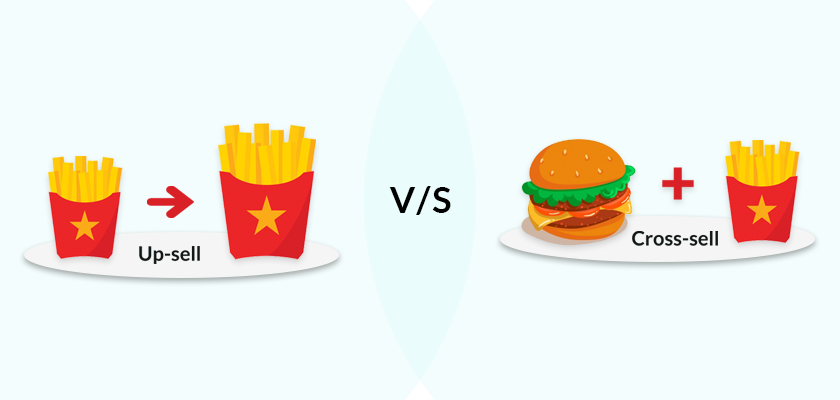
How to Increase Revenue of Your Shopify Store by Upselling and Cross-Selling
Upselling and cross-selling have become popular sales techniques, especially in e-commerce, that you can use to increase sales in your Shopify store. As the e-commerce industry becomes more and more competitive, you’’ll need to make your store stand out from the competition to generate sales and boost the revenue of your Shopify store. You can achieve this through upselling and cross-selling.
The benefit of these sales strategies is that, if you apply them correctly to your store, you can create golden opportunities for your e-commerce business, which will automatically affect your profit margin too.
What is upselling?
Upselling is a sales strategy that encourages customers to buy products from you by displaying an upgraded version of the product that they have already purchased or added to their cart.
The main aim of upselling is to increase your profit by encouraging your customers to buy a more expensive product. Upsells on your store can increase the Average Order Value (AOV) of your e-commerce store, which is one of the most important e-commerce metrics.
Since your customers are already interested in your products, you simply need to focus on showcasing upsells and cross-sells at the right time. By doing this you can maintain a long-lasting relationship with your customers. An example of upselling is if a customer is buying a laptop from your store and you then market the upgraded version of that product to them during the buying process.
What is cross-selling?
Cross-selling is a sales strategy implemented by store owners to encourage customers to purchase additional products from their store. They achieve this by showing related products based on what the customer has already purchased or added to their cart.
For example, if your customer is buying a laptop, you can display laptop accessories such as a mouse. The main goal of cross-selling is to increase the profit of the company and at the same time satisfy the customers’ needs by showing them relevant, complementary products. By showing cross-sells to your customer you can boost the Average Order Value of your store.
Cross-selling vs upselling
Cross-selling entails selling related products, while upselling is when you try to sell an upgraded or more expensive version of the product that the customer is intending to buy.

Boost your revenue with upselling and cross-selling on your store
If you want to increase the revenue of your store then both upselling and cross-selling can help you out. If you are not displaying upsells and cross-sells on your Shopify store, and even in the checkout phase, then you missing many golden opportunities to generate sales. But before implementing this strategy, it’s important to make sure that your cart is fully accessible to your customers at all times. This is where a sticky cart drawer comes in handy.
A sticky cart is an add to cart button that is always visible in your store that can help your customers easily add products to their cart without having to scroll to the top of the page every time. This improves the customer journey and buying process, saving your customers time.
Since online shopping nowadays is predominantly conducted via mobile, with over half of online shoppers being mobile users, this enhanced customer journey is even more essential.
To implement sticky cart, you can choose one of the ready-made Shopify apps, such as iCart Cart Drawer Cart Upsell, which will help you design your side cart so you can show upsells and cross-sells in the cart drawer. It will also help you attract more customers to your store with amazing upsell and cross-sell offers. By satisfying your customer needs you can also improve your customer retention.
Using an Upsell App to show upsells and cross-sells add value to customers’ lives, and at the same time can be beneficial to you in terms of revenue. To maintain a good business, one needs to maintain the overall lifetime value of each customer. If your customer is looking for a mobile phone, then show them headphones. If they are searching for a pair of shoes, show them socks. This can improve the conversion rate of your store. Try to provide them with many discounts like free shipping, gift wrapping, or any other offers. This will attract customers to your store and improve your chances of gaining customer referrals through recommendations and word of mouth.
Happy customers are more likely to be loyal to you. If they have a positive customer experience and like your products, they will probably become repeat customers. But you need to make sure to suggest the right products to the right customers. To do so, you need to conduct a customer journey analysis to study the shopping behavior of the customers. From those analyses, you can suggest the right choice of upsells and cross-sells for your customers. If your customers feel that you are simply pushing irrelevant products, then chances are that they will leave your store without performing any action i.e will abandon their carts. So your upsells and cross-sells should be relevant and appealing to your customers. You should also try to include social proof in your store so that you can generate trust.
Customers tend to buy after seeing reviews of the products that you sell. Displaying customer reviews in your store will help you gain credibility in the eyes of consumers, building trust and giving them a seamless shopping experience.
Conclusion
Want to boost your sales and increase the profit of your store? Start upselling and cross-selling in your store and see the change in your revenue. Target your customers, analyze which strategy works out better for them and apply them accordingly in your store. Show upsells and cross-sells in your store and measure the results.


 Please wait...
Please wait...




